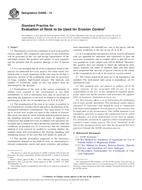Potrebujeme váš súhlas na využitie jednotlivých dát, aby sa vám okrem iného mohli ukazovať informácie týkajúce sa vašich záujmov. Súhlas udelíte kliknutím na tlačidlo „OK“.
ASTM D4992-14
Standard Practice for Evaluation of Rock to be Used for Erosion Control
Automaticky preložený názov:
Štandardná prax pre hodnotenie rock má byť použitý pre protieróznej
NORMA vydaná dňa 1.5.2014
Informácie o norme:
Označenie normy: ASTM D4992-14
Poznámka: NEPLATNÁ
Dátum vydania normy: 1.5.2014
Kód tovaru: NS-29425
Počet strán: 7
Približná hmotnosť: 21 g (0.05 libier)
Krajina: Americká technická norma
Kategória: Technické normy ASTM
Anotácia textu normy ASTM D4992-14 :
Keywords:
armor stone, breakwater stone: erosion control, laboratory testing, petrographic analysis, riprap, rock, rock durability, rock mass properties, rock material properties, ICS Number Code 91.100.15 (Mineral materials and products)
Doplňujúce informácie
| Significance and Use | ||||||||||||||||||||||||||
|
4.1 The field examination and petrographic examination in this practice along with appropriate laboratory testing may be used to determine the suitability of rock for erosion control. It should identify and delineate areas or zones of the rock, beds, and facies of unsuitable or marginal composition and properties due to weathering, alteration, structural weaknesses, porosity, and other potentially deleterious characteristics. 4.2 Both the rock mass properties and the rock material properties must be evaluated. 4.2.1 The rock mass properties are the lithologic properties of the in situ rock that must be evaluated on a macroscopic scale in the field. These would include features such as fractures, joints, faults, bedding, schistosity, and lineations, as well as the lateral and vertical extent of the rock unit. 4.2.2 The rock material properties are those lithologic properties that may be evaluated using small specimens and thus can be subject to meaningful laboratory testing. These properties would include mineral composition, grain size, rock hardness, degree of weathering, porosity, unit weight, and many others. 4.3 Rock proposed for use in erosion control applications will normally be classified as either filter bedding stone, riprap stone, armor stone, or breakwater stone. However, these procedures may be also extended to rocks used in groin and gabion structures. 1.1 This practice covers the
evaluation of rock to be used for erosion control. The complexity
and extent of this evaluation will be governed by the size and
design requirements of the individual project, the quantity and
quality of rock required, and the potential risk for property
damage or loss of human life.
1.2 It is not intended that all of the evaluations listed in this practice be addressed for every project. For some small, less critical jobs, a visual inspection of the rock may be all that is necessary. Several of the evaluations listed may be necessary on large, complex, high-hazard projects. The intensity and number of evaluations made on any one project must be determined by the designer. 1.3 Examination of the rock at the source, evaluation of similar rock exposed to the environment at any field installations, as well as laboratory tests may be necessary to determine the properties of the rock as related to its predicted performance at the site of intended use (1, 2, 3, 4, 5, 6).2 1.4 The examination of the rock at its source is essential to its evaluation for erosion control and aids in the planning of the subsequent laboratory examinations. Very large pieces of rock up to several tons weight are used in the control of erosion; thus great care must be taken with the field descriptions and in the sampling program to assure that zones of impurities or weaknesses that might not occur in ordinary size specimens are recorded and evaluated for their deleterious potential under the conditions of intended use. It is necessary that the intended method of rock removal be studied to ascertain whether the samples taken will correspond to the blasting, handling, and weathering history of the rock that will finally be used 1.5 The specific procedures employed in the laboratory examinations depend on the kind of rock, its characteristics, mineral components, macro and micro structure, and perhaps most importantly, the intended use, size of the pieces, and the exposure conditions at the site of use (1, 2, 3, 4). 1.6 It is assumed that this practice will be used by personnel who are qualified by education and experience to plan the necessary evaluations and to conduct them so that the necessary parameters of the subject rock will be defined. Therefore, this practice does not attempt to detail the laboratory techniques required, but rather to mention them and only detail those properties that must be of special concern in the course of the examination for rock to be used for erosion control. 1.7 The values stated in SI units are to be regarded as the standard. The inch-pound units given in parentheses are for information only. 1.8 This standard does not purport to address all of the safety concerns, if any, associated with its use. It is the responsibility of the user of this standard to establish appropriate safety and health practices and determine the applicability of regulatory limitations prior to use. 1.9 This practice offers a set of instructions for performing one or more specific operations. This document cannot replace education or experience and should be used in conjunction with professional judgment. Not all aspects of this practice may be applicable in all circumstances. This ASTM standard is not intended to represent or replace the standard of care by which the adequacy of a given professional service must be judged, nor should this document be applied without consideration of a project's many unique aspects. The word “Standard” in the title of this document means only that the document has been approved through the ASTM consensus process. |
||||||||||||||||||||||||||
| 2. Referenced Documents | ||||||||||||||||||||||||||
|
Odporúčame:
EviZak - všetky zákony vrátane ich evidencie na jednom mieste
Poskytovanie aktuálnych informácií o legislatívnych predpisoch vyhlásených v Zbierke zákonov od roku 1945.
Aktualizácia 2x v mesiaci !
Chcete vedieť viac informácii ? Pozrite sa na túto stránku.




 Cookies
Cookies
